|
1. What shape is it? A set will have a composition in space. Look at the ground plan. Do walls face the audience in parallel to the stage or on diagonal? What about columns, platforms, set pieces? Is there a dominant angle or orientation to the set? Your lighting will need to be in harmony with that. The designer has given this orientation to the set for a reason.
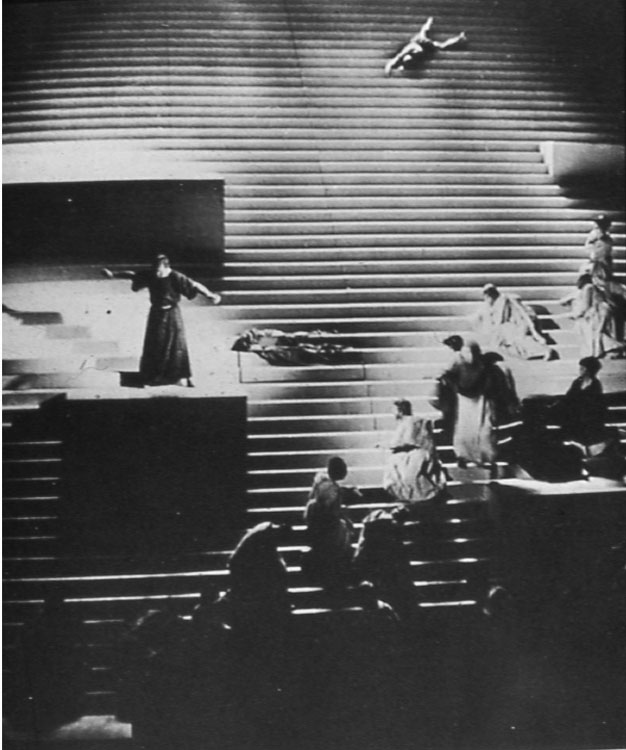 For example, Josef Swoboda抯 production of Oedipusconsisted of a vast set of stairs. The layout of the set was head on, facing the audience. The lighting for this obviously needs to be along the lines of the set, so for instance a diagonal backlight would be incorrect. This is for two reasons. The first is the way the light would hit the set itself: the shadows should be in harmony with the shape of the set. The second reason is that the movement of actors is affected by the layout of the set. If the set is parallel to the audience, with back and forth lines, that is how the actors are going to move, and the lighting will generally best bring out the mise en scene if it is in harmony with the shape of the set. Remember: all of these � mise en scene, set, costumes, lighting, should all be trying to get across the basic sense and message of the play. For example, Josef Swoboda抯 production of Oedipusconsisted of a vast set of stairs. The layout of the set was head on, facing the audience. The lighting for this obviously needs to be along the lines of the set, so for instance a diagonal backlight would be incorrect. This is for two reasons. The first is the way the light would hit the set itself: the shadows should be in harmony with the shape of the set. The second reason is that the movement of actors is affected by the layout of the set. If the set is parallel to the audience, with back and forth lines, that is how the actors are going to move, and the lighting will generally best bring out the mise en scene if it is in harmony with the shape of the set. Remember: all of these � mise en scene, set, costumes, lighting, should all be trying to get across the basic sense and message of the play.
A set built on diagonal lines will ask for diagonal lighting angles.
You should look at lots of pictures of scenery, and models if possible, and try and get an intuitive feel of the shape and composition of sets. How are the walls placed? Are there different levels of height? Can you identify a dominant direction or orientation?
2. Is the set made up of flat surfaces or does it have texture? If the set walls have texture, this will be invisible if you light the walls flat, that is, from an angle in front of them. . Textured surfaces need to be lit from the side, above, or below, with the light coming from as close as possible. In this way the light will cast shadows of the texture along the surface, and it will be visible to the audience. This is generally a good thing. First of all, the designer had it built with texture for a reason! And second, in general this will make it look more real and less like a flat fake piece of scenery.
To get an understanding of this, notice how walls of buildings look when the sun washes them uniformly, or when the setting sun sweeps along them from the side.
There抯 often no need to add instruments specifically to light the wall, as it might be getting good lighting from the indirect light cast by backlights or sidelights aimed at the actors.
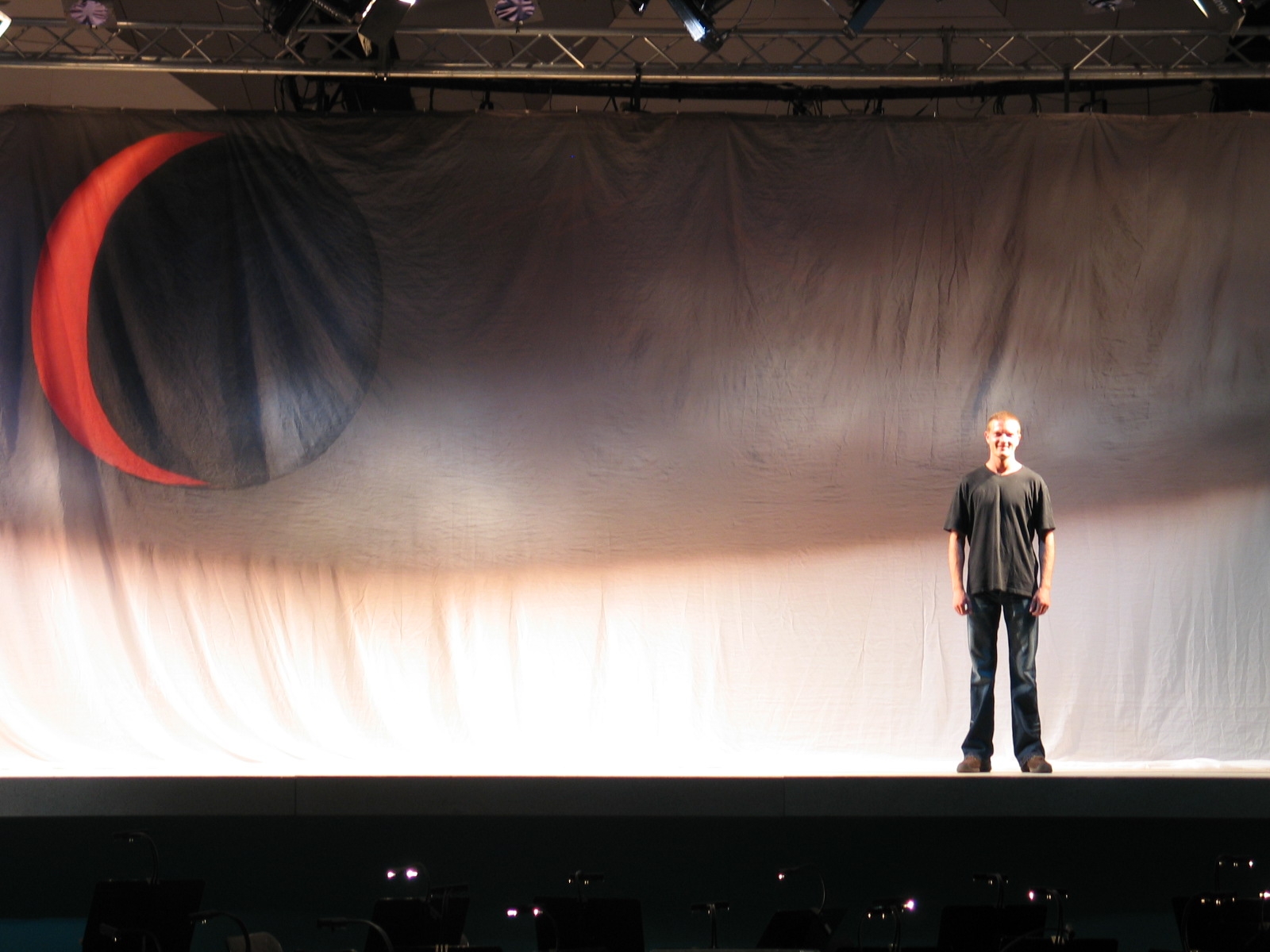 If you have a cyc or painted cloth, this must NOT be lit from the side, as that will show up any folds or wrinkles in the cloth (see photo). A cyc meant to represent a sky is generally lit by a three or four color unit (See: Fixtures). If the cloth is painted, it should be lit with enough color to bring out the colors in the painting; for instance a cloth with a painting that has lots of yellow and orange should not be lit only in blues. It抯 often a nice idea to highlight some detail in the painting. For example I lit a production of The Nutcracker where the backcloth was a painting of the living room, with four lamps containing candles and a grandfather clock. I lit the candles with pinspots, so that they glowed a bit more than the general background. The clock face was lit with green at an appropriate scary moment, and loomed out of the background. If you have a cyc or painted cloth, this must NOT be lit from the side, as that will show up any folds or wrinkles in the cloth (see photo). A cyc meant to represent a sky is generally lit by a three or four color unit (See: Fixtures). If the cloth is painted, it should be lit with enough color to bring out the colors in the painting; for instance a cloth with a painting that has lots of yellow and orange should not be lit only in blues. It抯 often a nice idea to highlight some detail in the painting. For example I lit a production of The Nutcracker where the backcloth was a painting of the living room, with four lamps containing candles and a grandfather clock. I lit the candles with pinspots, so that they glowed a bit more than the general background. The clock face was lit with green at an appropriate scary moment, and loomed out of the background.
If walls are flat and bright you can light them with break-up gobos that are slightly out of focus, to soften the surface. The acting light will blur the gobos, but they'll break up the flatness of the background and this will help visibility for the actors' faces .
3. What three dimensional elements does the set contain? Any pillars or shapes should be lit from an expressive angle, which means an angle that causes them to cast a shadow. This may happen automatically as a result of Question 1 above � taking into account the shape of a set generally means choosing a basic expressive angle to light it, and this will cast shadows of the three dimensional set pieces that are in harmony with the general shape of the set.
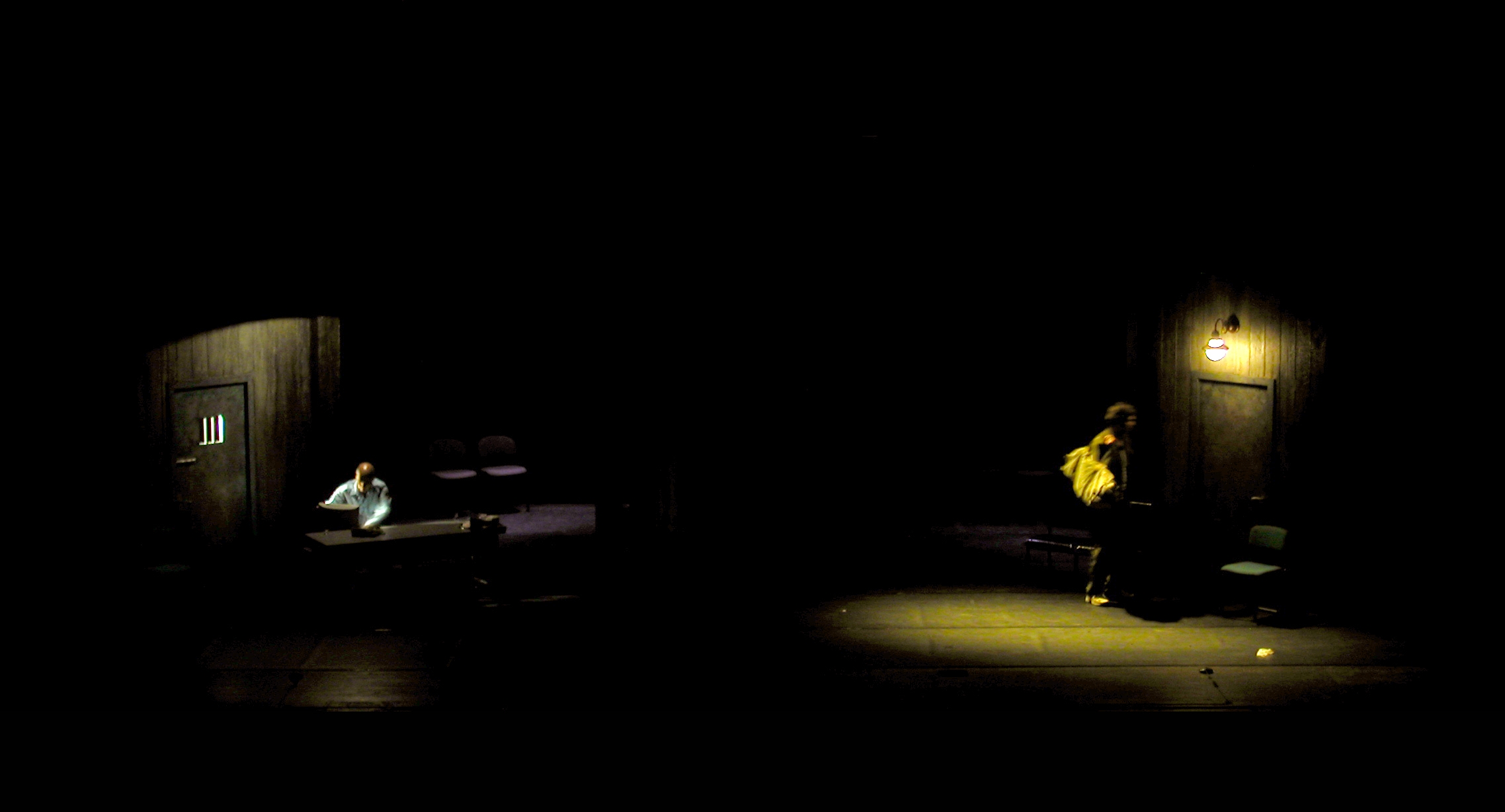 4. Does the set have openings? All doors, windows or other openings need light behind them. And you need to give an impression, almost always, that there is a world behind the opening. So a door will need light coming through it when it's open, and there should also be light illuminating the area behind the door that is visible when it is opened. A window might need lights of various colors and angles coming through it, depending on time of day. Usually there is something visible through the window that needs to be lit � either a sky cloth or some kind of scenery. 4. Does the set have openings? All doors, windows or other openings need light behind them. And you need to give an impression, almost always, that there is a world behind the opening. So a door will need light coming through it when it's open, and there should also be light illuminating the area behind the door that is visible when it is opened. A window might need lights of various colors and angles coming through it, depending on time of day. Usually there is something visible through the window that needs to be lit � either a sky cloth or some kind of scenery.
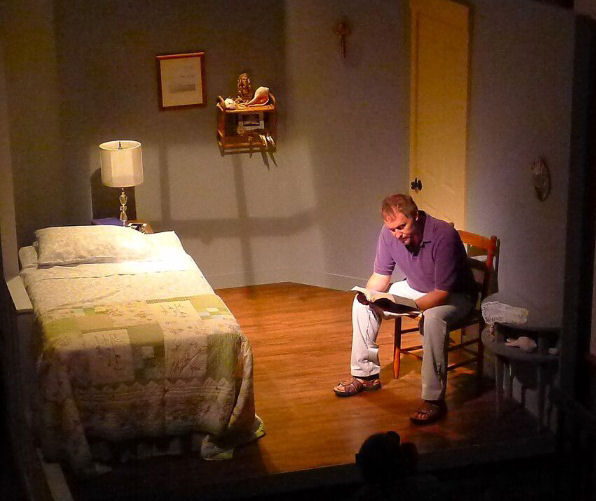 5. Are there practical needs? Are there any lamps, fireplaces or other light emitting details in the set? These may need to work in themselves, and can also give you a good anchor to base your lighting on. A lamp in the corner can lead to a diagonal light coming from that corner. Are there other realistic lighting constraints in the set? A window with a green curtain might hint that you should have green light coming from that angle. 5. Are there practical needs? Are there any lamps, fireplaces or other light emitting details in the set? These may need to work in themselves, and can also give you a good anchor to base your lighting on. A lamp in the corner can lead to a diagonal light coming from that corner. Are there other realistic lighting constraints in the set? A window with a green curtain might hint that you should have green light coming from that angle.
5. What specific details need to be addressed? Are there any details of the set that need special treatment? Examples could be a semi transparent gauze or screen, which needs at times to be transparent and at others opaque. When you light behind it but do not light the cloth, it抯 transparent; when you light the cloth it抯 opaque.
Are there fiberglass or cloth surfaces in the set whose texture or transparency should be heightened?
5. What other opportunities or pitfalls are there? Look for problems and opportunities to position lights. (This should be done early, when you first see the model � during production week it will be too late!) If the set has walls all around, or a ceiling above, it will be hard to light it from the side or above. When you first see the model, you might ask if slits could be added so that light can come through. The area behind a window might be lit by lights positioned on the back of the wall that contains the window.
FINALLY: A set can help you when you don抰 know what to do with the play. Sometimes the model will tell you how the play needs to be lit; the simplest example is a set with a big diagonal wall with a window, and a sky behind it. Obviously in daylight scenes, light will come from the window, and that can be the dominant light for the scene. Even less blatant examples will help you. What colors are there in the set? If they are primary colors, red, blue and green, it might help you understand that the lighting needs to be bright and brash. Remember, the set designer has thought about the play perhaps even longer than you have, and is the person in the production who more than anyone else speaks your language – a visual language.
|







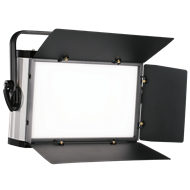
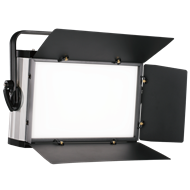
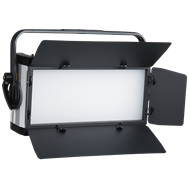

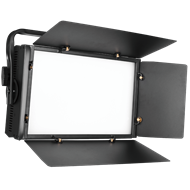


 For example, Josef Swoboda抯 production of Oedipusconsisted of a vast set of stairs. The layout of the set was head on, facing the audience. The lighting for this obviously needs to be along the lines of the set, so for instance a diagonal backlight would be incorrect. This is for two reasons. The first is the way the light would hit the set itself: the shadows should be in harmony with the shape of the set. The second reason is that the movement of actors is affected by the layout of the set. If the set is parallel to the audience, with back and forth lines, that is how the actors are going to move, and the lighting will generally best bring out the mise en scene if it is in harmony with the shape of the set. Remember: all of these � mise en scene, set, costumes, lighting, should all be trying to get across the basic sense and message of the play.
For example, Josef Swoboda抯 production of Oedipusconsisted of a vast set of stairs. The layout of the set was head on, facing the audience. The lighting for this obviously needs to be along the lines of the set, so for instance a diagonal backlight would be incorrect. This is for two reasons. The first is the way the light would hit the set itself: the shadows should be in harmony with the shape of the set. The second reason is that the movement of actors is affected by the layout of the set. If the set is parallel to the audience, with back and forth lines, that is how the actors are going to move, and the lighting will generally best bring out the mise en scene if it is in harmony with the shape of the set. Remember: all of these � mise en scene, set, costumes, lighting, should all be trying to get across the basic sense and message of the play.
 If you have a cyc or painted cloth, this must NOT be lit from the side, as that will show up any folds or wrinkles in the cloth (see photo). A cyc meant to represent a sky is generally lit by a three or four color unit (See:
If you have a cyc or painted cloth, this must NOT be lit from the side, as that will show up any folds or wrinkles in the cloth (see photo). A cyc meant to represent a sky is generally lit by a three or four color unit (See: 

 Sales Manager Lok
Sales Manager Lok
